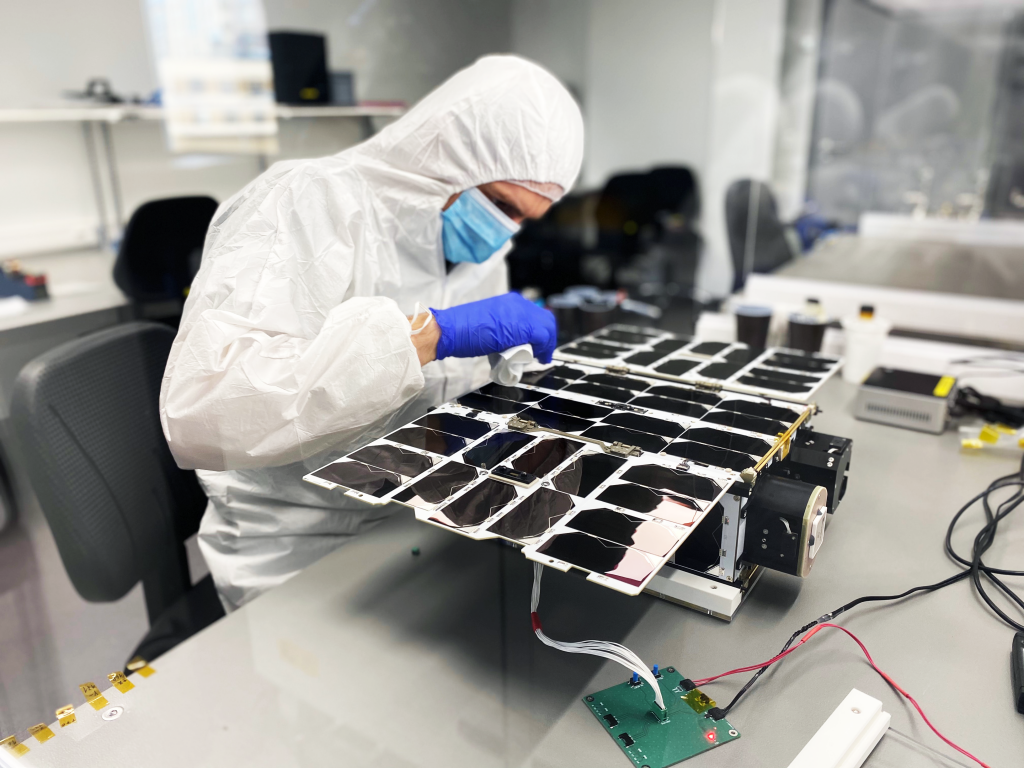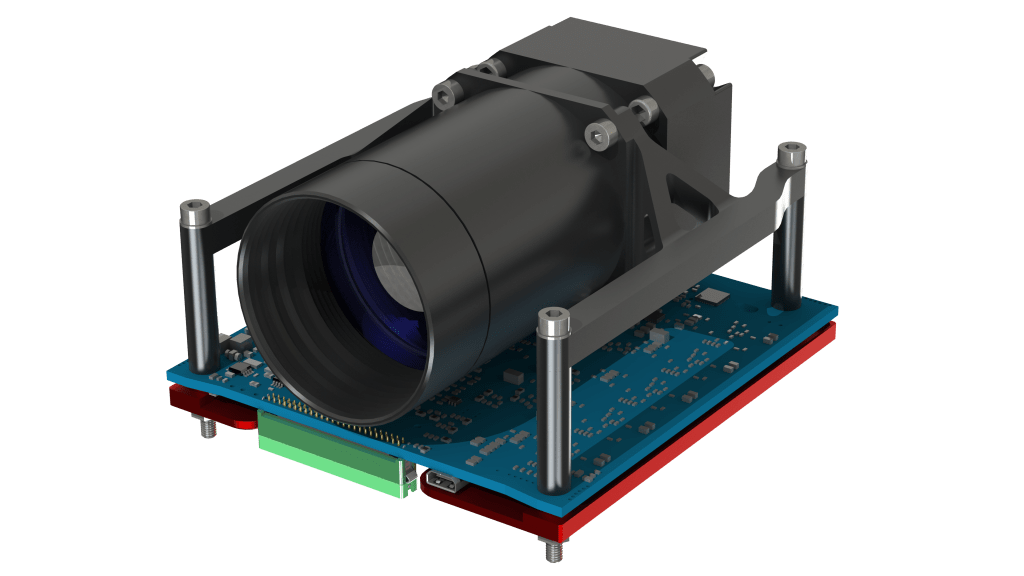Be part of the future with us!
Register now for our online product launch event on May 23rd.
NanoAvionics, a leading nanosatellite bus manufacturer and mission integrator, has revealed the remaining three payloads of its ‘D-2/AtlaCom-1’ rideshare mission hosted on board its M6P 6U nanosatellite bus. The additional payloads, a camera for hyperspectral remote sensing, a new high-gain X-band antenna and an upgraded X-Band downlink transmitter, are all part of an international collaboration by an international consortium and its partners called “HyperActive”.
The consortium partners for this international collaboration comprise Dragonfly Aerospace (South Africa), Space JLTZ (Mexico) and NanoAvionics US as a supplier to the consortium, as well as mission contributors Polytechnical University of Atlacomulco (Mexico), and CubeCom (South Africa). Expected to launch in mid-2021, the primary aim of the HyperActive program is a flight demonstration of the hyperspectral imaging and communication payloads. The secondary aim is to evaluate market interest for hyperspectral imaging data captured and processed as part of the program.
Within this collaboration, NanoAvionics will act as the supplier to the HyperActive consortium, taking care of all aspects related to the satellite mission including among others payload integration, performance testing, spacecraft registration and logistics, frequency allocation and payload on-orbit operations.

“This program shows how important international collaboration can be to the NewSpace sector and how it enables low barrier entry for space data businesses,” said F. Brent Abbott, CEO of NanoAvionics US, “I’m very proud that NanoAvionics is part of this effort as well as stimulating education development and contributing to global social benefits such as ocean and agricultural monitoring. NanoAvionics also values its role as a strategic ally for space development in Mexico.”
A key instrument of the program is the “Mantis imager”, a hyperspectral camera for remote sensing developed by Dragonfly Aerospace, based in Stellenbosch, South Africa. The Mantis imager has an additional unique software capability allowing it to combine any of the available 148 hyperspectral bands into customizable multispectral bands as required for an individual imaging session – essentially a “software defined” camera. To capture these hyperspectral bands, the camera features a 16-meter native ground sample distance (GSD) and a hyperspectral resolution of 32 meters. Dragonfly Aerospace will also provide an X-band data download ground station for the mission. The high-gain X-band antenna and transmitter to send the data back to Earth, are products of the consortium’s partner CubeCom.

“The team at Dragonfly Aerospace is excited to be working with these great partners on this mission,” said Bryan Dean, CEO of Dragonfly Aerospace. “It fits very well with our plans to team up with leading satellite bus and image processing partners to provide compelling solutions to end users. The Mantis imager is the latest addition to our range of cost-effective hyperspectral imagers which also includes the Chameleon imager that we delivered for flight earlier this year.”



Responsible for processing the collected hyperspectral data and distributing it to interested parties around the world is Space JLTZ, a space company from Puebla, Mexico. The generated data can be used to construct national capacities in the prioritary social task of protecting our populations against natural disasters, develop innovation solutions to optimize various industries such as energy, mining, livestock, pollutants monitoring, early warning for forestal fires, and to improve agriculture productivity for the alimentary security. For example, a hyperspectral sensor can ‘see’ the spectral signature of an invasive disease threatening an entire harvest, allowing farmers to take preventive steps. Initially, the data will be openly available to all interested parties worldwide, especially including the Polytechnical University of Atlacomulco for its systematization, which will allow its students to explore and discover new possible applications.
José Luis Terreros Corrales, CEO & president of Space JLTZ, said: “It is a well-known truth that space exploration is the next step for humankind. Speaking as president of Space JLTZ but mostly as a Mexican I couldn’t be more excited and prouder of launching this project and sending Mexico onto a space path. We know this alliance with two giants, NanoAvionics and Dragonfly, is only the beginning of a great partnership that will change the course of the space industry in Mexico.”
F. Brent Abbott: “Mexico’s participation in the AtlaCom-1 project is possible thanks to the support of Space JLTZ, its extraordinary team and its visionary CEO and president, José Luis Terreros Corrales, the long-term vision and amazing efforts around AtlaCom-1 by the Mexican Space Agency ‘s Head, Dr. Salvador Landeros, and especially the exemplary support of the Municipality of Atlacomulco of Mexico and its space enthusiastic Mayor and engineer, Roberto Tellez Monroy, this team is making history and have laid the ground work to establish a nanosatellite infrastructure for the future space missions in Mexico.”
About Dragonfly Aerospace:
Dragonfly Aerospace is a South African space company focused on creating high-performance imaging payloads that are designed for compact satellites enabling large imaging constellations. Dragonfly Aerospace is based in Techno Park Stellenbosch in a design and manufacturing facility geared for constellation production. Dragonfly Aerospace products are based on a 20+ year space heritage which includes six microsatellites and another six payloads. Members of our team have worked on every microsatellite space project since South Africa entered the space race nearly 40 years ago.
www.dragonflyaerospace.com | LinkedIn: https://www.linkedin.com/company/dragonfly-aerospace/ | Twitter: @dragonfly_space |
About Space JLTZ:
Space JLTZ is a Mexican Startup currently based in Puebla (MX). Committed to research, commercialization and spatial technology development. The company’s mission is to boost the spatial industry in Mexico through the development of satellite and IoT products and services, designed to satisfy the needs of the Mexican market by the use of national technology. Company’s main goal is to put technology within reach of humanity and place Mexico as one of the most advanced countries in the world regarding manufacturing and commercialization of spatial technology.
www.jltz.space | LinkedIn: https://www.linkedin.com/company/spacejltz | Facebook: @SpaceJLTZ | Twitter: @SJltz |
About NanoAvionics:
NanoAvionics is a nanosatellite bus manufacturer and mission integrator currently based in four locations – Columbia (US), Midland (US), Vilnius (Lithuania), and Oxfordshire (UK). Its flagship multi-purpose M6P and M12P are the first preconfigured nanosatellite buses in the sector, designed to serve emerging commercial space markets. The company’s efforts are focused on enabling critical satellite functions and optimising their launch, hardware and operation costs – ranging from single missions to constellations. Its core engineering team has implemented over 75 successful satellite missions and commercial projects during the past several years.
www.nanoavionics.com | LinkedIn: https://www.linkedin.com/company/nanoavionika-uab/ |Facebook: https://www.facebook.com/NanoAvionics/ | Twitter: @NanoAvionics |